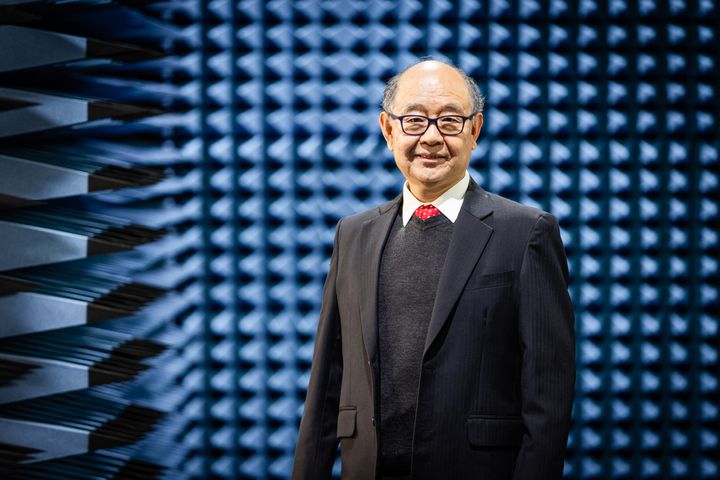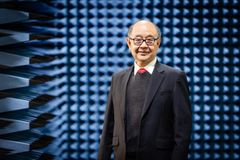Multibeam antennas to play an important role in 6G
Professor Yingjie Jay Guo is the Director of Global Big Data Technologies Centre at University of Technology Sydney. He has over thirty years of international academic, and industrial experience. We sat down with him to discuss about the role of antennas in the future of 6G development.

Your research has spanned decades, from early antenna innovations to 6G. What do you see as the biggest breakthrough in antenna technology over the past 20 years?
There have been many major antenna technologies breakthroughs in the past 20 years. Personally, I think metasurfaces and metamaterials are the most impactful breakthroughs. The technology has been employed and embedded in numerous, if not all types of antennas, ranging from antenna elements and conventional antenna arrays to ultra-wideband arrays, reflectarrays/transitarrays and 4G/5G base station antennas.
Analogue multibeam antennas are a key part of your research. What advantages do they offer over digital beamforming, and where do you see them making the biggest impact and why?
We have been focusing our antenna research on analogue multibeam antennas in the last five years. This was for two reasons. First, we saw it as a scientific gap as there had been limited research to produce multibeams employing analogue antenna configurations, such as conventional arrays and transmit arrays. Secondly, most modern communication systems support multiusers, which requires dynamic multibeam antennas. This is normally done through digital beamforming. Although digital beamforming is very powerful and flexible, they do consume a significant amount of energy and are not cheap, especially for wideband systems. Analogue multibeam antennas serve as a low-energy consumption and low-cost alternative solution. Therefore, we expect the technology to play an important role in 6G.
6G is expected to support highly flexible, software-driven networks. How do hardware innovations fit into this evolving landscape?
The software driven 6G networks are expected to be more intelligent and offer unprecedented flexibility. This would require the support of reconfigurable hardware modules from networking equipment to antennas. We have been researching on reconfigurable antennas for two decades. It is fair to say that, until very recently, most research outputs had primarily stayed in university labs. This is expected to change dramatically for 6G. The reconfiguration in the hardware can quite often deliver a few dB gains in signal quality and network performance easily, which translates into significant energy savings and coverage extensions. In the last decade, the advancement of communications signal processing research has largely based on the assumption of fixed hardware. Changing this paradigm would give us opportunities for new breakthroughs in 6G. Specifically, we expect AI and hardware reconfigurability will work together to make 6G much more intelligent, flexible, and energy and cost effective.
Tell us about the GJC matrix approach? This GJC matrix approach allows for individually steerable independent multibeams. How does this differ from conventional feed networks, and what new applications does it enable?
Existing analogue multibeam feed networks are suited for fixed beams. The most well known one is the Butler matrix. The generalised joined coupler matrix we invented, or the GJC matrix for short, makes it possible to produce individually and independently steerable multibeams using analogue circuits. We can use the GJC matrix to replace some digital beamformers to save energy and cost. We can use the GJC matrix in hybrid arrays. Most recently, we are using the GJC matrix to create reconfigurable antenna arrays to support flexible architectures for future communications systems like 6G. The research on the GJC matrix is just at the beginning, and we expect many innovations will be enabled by its potential ability.
6G is expected to integrate sensing and communications (ISAC). How do you see this influencing antenna design, and what are the challenges that remain to be solved?
ISAC research is still in its infancy. Most use cases outlined by 3GPP have not been studied properly, let alone thoroughly. As a result, many requirements remain largely unknown. We have been focusing our ISAC research on environmental sensing. To our knowledge, there has been little research to understand the effect of various environmental changes on the propagation of electromagnetic waves. Further, if one aims to do passive sensing using the signals transmitted from the base station and refracted from the environment, we need highly sensitive receivers in conjunction with high gain/narrow beam antennas. The challenge is to accommodate both the communications and various sensing needs without over-complicating the system in future 6G base stations designs. A key part of this challenge is the design of a smart antenna beamforming strategy and its realisation.
You’ve worked in both academia and industry, including leading research at CSIRO. How has that experience shaped your approach to innovation?
My industry and CSIRO experience has shaped my approach to innovation in two different ways. The first is to prioritise innovate at the system level and then tackle the problems arising at lower levels. I quite often found that new systems create new scientific problems to solve. Further, certain issues at the device level may be easily addressed at the system level. The second is to actively seek multidisciplinary collaboration, aiming to find best and easiest way to tackle any problem we are facing without being bounded by conventional discipline limitations.
With over 800 papers and 27 patents, you’ve been a prolific contributor to the field. What advice do you have for early-career researchers looking to make an impact? With the scope of knowledge you have, are there any moments you’d do differently now that you look back on your career so far?
I would like to offer the following three pieces of advice to early-career researchers. First, it is important to have a conviction and become an expert in one area through dedication and persistence and leave your mark. Second, it is equally important to keep the large picture in mind. You need to be aware of the high-level goal and landscape of your research field. Third, never make your research field too narrow.
Reflecting on my career, I have made many mistakes. My research interest was too narrow in the early stage, so I missed some great opportunities. Also, I could have focused on certain research topics for longer. For instance, I invented the hybrid array concept together with my colleagues at CSIRO. We knew it was important, but we didn’t work on it long enough to broaden our research from point-to-point systems to multiuser systems. As it turns out, hybrid arrays became a very important research topic and technology five years later.
What’s the one thing we’re still not talking about enough that we really should be, and why?
One thing we haven’t talked about enough is international collaboration. To grow our future research leaders, we should expose our early career researchers including PhD students with the global research landscape and encourage them to build their own professional networks early. This would help broaden their knowledge and accelerate their talent development. It will also benefit all the research teams and projects they get involved. To this end, we are keen to establish such kind of collaborations between the University of Oulu and University of Technology Sydney, the 6G Flagship and GBDTC in particular.
Want to know more about the key antenna technologies that are vital to deliver 6G functionalities with high performance? Check out a vision paper written by Jay Gyo and 6G Flagship Director Matti Latva-aho available from https://ieeexplore.ieee.org/document/10930518
Professor Yingjie Jay Guo´s bio https://profiles.uts.edu.au/Jay.Guo
Read this article and many more in the 10th issue of 6G Waves, coming out on 3rd June!
Avainsanat
Yhteyshenkilöt
Ville WittenbergCommunications Specialist
Science communications: information technology and 6G Flagship programme
Kuvat

Tilaa tiedotteet sähköpostiisi
Haluatko tietää asioista ensimmäisten joukossa? Kun tilaat tiedotteemme, saat ne sähköpostiisi välittömästi julkaisuhetkellä. Tilauksen voit halutessasi perua milloin tahansa.
Lue lisää julkaisijalta University of Oulu
6G test centre´s strategic role – pioneering dual-use innovation within NATO DIANA21.5.2025 09:09:00 EEST | Tiedote
The 6G Test Centre (6GTC) in the University of Oulu is at the forefront of dual-use innovation. It leverages the Arctic's extreme conditions to push the boundaries of 5G and 6G validation. Also, 4G testing is available. The centre addresses critical challenges in the defence and commercial sectors by integrating AI-driven network optimisation and seamless network transitions.
Harri Pennanen - writing the future of 6G, one blink at a time14.5.2025 07:07:00 EEST | Tiedote
There are researchers who define their field, and then there are those who, by force of intellect and persistence, redefine what is possible. Harri Pennanen, a Postdoctoral Researcher at the University of Oulu's Centre for Wireless Communications (CWC), belongs to the latter category. His recent work, the most comprehensive survey of 6G technology to date, not only pushes the boundaries of wireless communication but also embodies resilience, the disciplined pursuit of knowledge despite constraints, and the refusal to accept imposed limitations.
Sustainable exploration for green transition in mining industry8.5.2025 09:30:30 EEST | Tiedote
Critical raw materials are fundamental to feeding the EU industrial value chains and strategic sectors and the green energy transition. SEMACRET project, led by the University of Oulu Finland, promoted sustainable exploration for green transition critical raw materials in the EU, securing the continued supply for its industries.
Breakthrough in multifunctional solar cells13.3.2025 08:15:00 EET | Uutinen
A recent article published by the research team led by Associate Professor Yang Bai from University of Oulu is highlighted as the back cover on the journal of Advanced Electronic Materials.
Academy Professor Guoying Zhao awarded valued IAPR 2024 Maria Petrou prize11.12.2024 09:07:49 EET | Tiedote
The 2024 Maria Petrou Prize recipient is Guoying Zhao, University of Oulu Finland. She was recently awarded for her contributions to video analysis for facial micro-behavior recognition and remote bio-signal reading (RPPG) for heart rate analysis and face anti-spoofing.
Uutishuoneessa voit lukea tiedotteitamme ja muuta julkaisemaamme materiaalia. Löydät sieltä niin yhteyshenkilöidemme tiedot kuin vapaasti julkaistavissa olevia kuvia ja videoita. Uutishuoneessa voit nähdä myös sosiaalisen median sisältöjä. Kaikki tiedotepalvelussa julkaistu materiaali on vapaasti median käytettävissä.
Tutustu uutishuoneeseemme